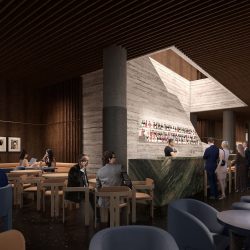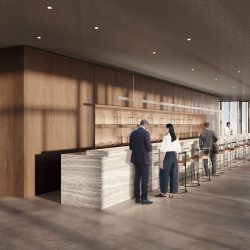
David Chipperfield Architects . Ester Bruzkus Architekten
The American hotel and restaurant operator Nobu is planning a new location in the Elbtower in Hamburg’s Hafencity. The Nobu Hotel will occupy two of the three wings in the seven-storey base of the tower. The interior is designed by the Elbtower architects David Chipperfield Architects Berlin in collaboration with Ester Bruzkus Architekten.
Following the concept of the Nobu Hotels, the restaurant forms the heart of the hotel. Guests are led up a prominent staircase from the entrance level to the first-floor restaurant. Flanking the stair hall, a cocktail lounge is overlooking the river Elbe. At the far end of the dining room, the sushi bar is theatrically lit as the main focus of the room, framed by walls of panelled glass, mirror, and wood. The furniture in the hall is designed to create smaller, intimate areas within the space, with guests able to look out over the entire space.
188 hotel rooms and suites, some with private roof terraces, are located on the four floors above the restaurant. On the sixth floor, a bar with a spacious outdoor area offers a panoramic view over the river Elbe and Hamburg’s HafenCity. The fitness club with spa facilities and an outdoor Japanese onsen bath are situated on the same floor. On the 56th floor, just above the public viewing terrace of the tower, a special highlight – the Nobu members club – extends the view over the whole of Hamburg and beyond.
The design, materiality and colour scheme of the Hamburg Nobu hotel are inspired by the characteristic features of its local environment. The selected materials provide an authentic representation of the local northern German landscape – with its harbour, the sea, sand, shells and plants. Simple, natural materials of the highest quality create an atmosphere that is characterised by the contrast between cool concrete, natural stone and warm wood. The clear, reduced design language with finely crafted details approximates Japanese design principles and draws its inspiration in the simplicity of the preparation of Japanese food.
_







